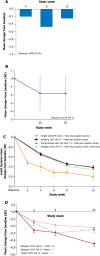Selective Pharmacologic Therapies for Dry Eye Disease Treatment: Efficacy, Tolerability, and Safety Data Review from Preclinical Studies and Pivotal Trials
- PMID: 35608780
- PMCID: PMC9253213
- DOI: 10.1007/s40123-022-00516-9
Selective Pharmacologic Therapies for Dry Eye Disease Treatment: Efficacy, Tolerability, and Safety Data Review from Preclinical Studies and Pivotal Trials
Abstract
Keratoconjunctivitis sicca, also known as dry eye disease (DED), is a prevalent, multifactorial disease associated with compromised ocular lubrication, ocular surface inflammation and damage, and ocular symptoms. Several anti-inflammatory, topical ophthalmic therapies are available to treat clinical signs and symptoms of DED in the USA and Europe. Cyclosporine A (CsA)-based formulations include an ophthalmic emulsion of 0.05% CsA (CsA 0.05%), a cationic emulsion (CE) of CsA 0.1% (CsA CE), and an aqueous nanomicellar formulation of 0.09% CsA (OTX-101). Lifitegrast is a 5% ophthalmic solution of a lymphocyte function-associated antigen 1 antagonist that is believed to target T cell activation and recruitment to inhibit ocular inflammation. Here we provide a comprehensive review summarising preclinical studies and pivotal trial data for these treatments to provide a complete understanding of their efficacy and safety profile. Overall, data in the evaluated studies show a favourable risk-benefit profile for the use of targeted topical anti-inflammatory pharmacologic treatments in patients with DED. Pivotal trials for CsA 0.05%, CsA CE, OTX-101, and lifitegrast clearly demonstrate treatment efficacy compared to vehicle across treatments with no serious ocular treatment-emergent adverse events (TEAEs). Patients using ophthalmic treatments reported ocular TEAEs more frequently than those treated with vehicle; however, relatively few TEAEs led to treatment discontinuation. The specific signs and symptoms of DED that improve with treatment vary with the treatment prescribed. Long-term and direct comparative studies between treatments are needed to further understand treatment differences in efficacy and safety profiles.
Keywords: Cyclosporine A; Dry eye; Keratoconjunctivitis sicca; Lifitegrast; OTX-101; Ocular drug therapy; Ocular inflammation; Tear deficiency.
© 2022. The Author(s).
Figures



Similar articles
-
Real-world treatment patterns of OTX-101 ophthalmic solution, cyclosporine ophthalmic emulsion, and lifitegrast ophthalmic solution in patients with dry eye disease: a retrospective analysis.BMC Ophthalmol. 2023 Nov 2;23(1):443. doi: 10.1186/s12886-023-03174-y. BMC Ophthalmol. 2023. PMID: 37919692 Free PMC article.
-
One-Year Efficacy and Safety of 0.1% Cyclosporine a Cationic Emulsion in the Treatment of Severe Dry Eye Disease.Eur J Ophthalmol. 2017 Nov 8;27(6):678-685. doi: 10.5301/ejo.5001002. Eur J Ophthalmol. 2017. PMID: 28708219 Free PMC article. Clinical Trial.
-
Quintessence of currently approved and upcoming treatments for dry eye disease.Graefes Arch Clin Exp Ophthalmol. 2025 Feb;263(2):269-278. doi: 10.1007/s00417-024-06587-7. Epub 2024 Aug 31. Graefes Arch Clin Exp Ophthalmol. 2025. PMID: 39215848 Review.
-
A Review of Topical Cyclosporine A Formulations-A Disease-Modifying Agent for Keratoconjunctivitis Sicca.Clin Ophthalmol. 2020 Feb 20;14:481-489. doi: 10.2147/OPTH.S228070. eCollection 2020. Clin Ophthalmol. 2020. PMID: 32109984 Free PMC article. Review.
-
A Comprehensive Review of the Clinical Trials Conducted for Dry Eye Disease and the Impact of the Vehicle Comparators in These Trials.Curr Eye Res. 2021 May;46(5):609-614. doi: 10.1080/02713683.2020.1836226. Epub 2020 Nov 25. Curr Eye Res. 2021. PMID: 33238774 Review.
Cited by
-
Advances in Nanogels for Topical Drug Delivery in Ocular Diseases.Gels. 2023 Apr 2;9(4):292. doi: 10.3390/gels9040292. Gels. 2023. PMID: 37102904 Free PMC article. Review.
-
Long-Term Safety and Efficacy of a Water-Free Cyclosporine 0.1% Ophthalmic Solution for Treatment of Dry Eye Disease: ESSENCE-2 OLE.Cornea. 2024 May 21;44(6):692-700. doi: 10.1097/ICO.0000000000003567. Cornea. 2024. PMID: 38771801 Free PMC article. Clinical Trial.
-
Efficacy and Safety of Perfluorohexyloctane in Evaporative Dry Eye Disease Associated With Meibomian Gland Dysfunction: A Systematic Review and Meta-Analysis of Randomized Controlled Trials.Cureus. 2024 Aug 27;16(8):e67920. doi: 10.7759/cureus.67920. eCollection 2024 Aug. Cureus. 2024. PMID: 39206330 Free PMC article. Review.
-
Developments in Emerging Topical Drug Delivery Systems for Ocular Disorders.Curr Drug Res Rev. 2024;16(3):251-267. doi: 10.2174/0125899775266634231213044704. Curr Drug Res Rev. 2024. PMID: 38158868 Review.
-
Dry eye disease caused by viral infection: Past, present and future.Virulence. 2024 Dec;15(1):2289779. doi: 10.1080/21505594.2023.2289779. Epub 2023 Dec 4. Virulence. 2024. PMID: 38047740 Free PMC article. Review.
References
Publication types
LinkOut - more resources
Full Text Sources

